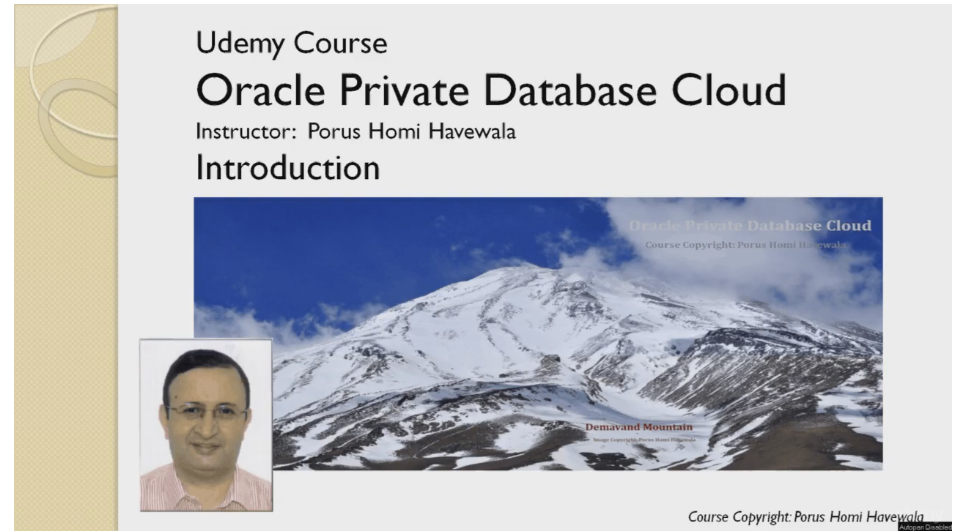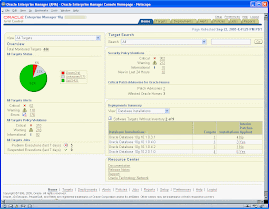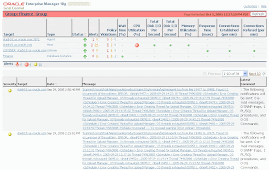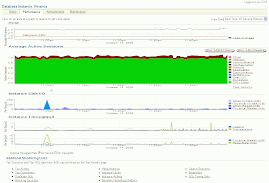Here are some favourite questions and answers from the EM webinar,
the answers may benefit all of you. I have put the most interesting
questions at the top.
Q. Is Oracle Enterprise Manager a licensed Product?
A. Base EM Grid Control software is free, you can install EM Grid Control on a separate server,
and then put EM agents on your target servers and start basic monitoring. When you start using the EM Packs like Diagnostics/Tuning/Config. Mgt/Change Mgt/Provisioning and Patch Automation Pack etc, you pay the licence fee per target server you use it on. For the cost please contact your local sales rep.
for an idea of the features in each pack. If you use any of these features, you need the licence.
Another method to find out which pack is required is to use the + link at the bottom of the EM console, this shows what packs are required on each page.
Q. Can you give a noteID for us to follow on how to install the Oracle Enterprise managment?
A. Please see Master Note for Grid Control 11.1.0.1.0 Installation and Upgrade [ID 1067438.1], this is on My Oracle Support.
Q. How much impact is on performance if standalone Oracle Enterprise Manager
Database Control Console is running on the Database Server machine?
A. There is an impact since after all it is a JVM application running on
your database server, and as per the old rule, database servers should
not have applications on them. I recommend instead using Grid Control on
a separate non-Exadata machine and just putting agents on your Exadata
database servers.
Q. What is SQL Profile, is it a separate pack? Do we need to purchase
or is it in built with Oracle Enterprise Edition?
A. SQL Profile is a feature of the EM Tuning Pack, so you need to purchase
the Tuning Pack. You also need to get the Diagnostics pack which works to
find issues first. These packs are not included in the Oracle Enterprise
Edition database licence.
Q. In EM 10g, all components of Enterprise Manager Grid Control are bundled.
But in EM 11gR1, we need to install Oracle Database, WebLogic Server and Grid Control
separately. What is Oracle's philosophy behind this new installation scenario?
Please explain.
A. In EM 10g, database software was bundled but was often behind the current
version, for eg. 10.1 was used as the bundled database version. Serious production
users never used the budnled version since they wanted to use the more recent
database version which was better all around. So the decision was taken to
remove the bundled database software so there is no version lag issue.
Likewise for the application server software.
Q. Where can I get the Forrester report on OEM ROI ?
Q. Where can we get the Installers for Oracle Enterprise Management?
Q. With Oracle EM 11g, Can it is possible to manage 9i, 10g DB ?
A. Yes, most definitely. You can manage all of 9i, 10g, 11g Oracle databases.
You can also manage Application Servers, Hosts and Applications etc. ie. a lot
of other things.
Q. Migrate DB from Sun V series to Sun T series (having Chip Multithread technology) shows
some batch precesses running slow. Can Enterprise manager Real Application Testing solve this type of issue?
A. Yes, definitely, also use Diagnostics and Tuning packs in addition to RAT. All three of these work together.
Q. Can I upgrade directly an existing Oracle Enterprise Manager 10g Grid Control Release (10.1.0.x) to Oracle Enterprise Manager 11g Grid Control Release 1 (11.1.0.1.0)?
A. Yes, upgrade is possible, Your repository and targets info will be retained. Please refer to EM documentation for the upgrade. Also see the Master Note for Grid Control 11.1.0.1.0 Installation and Upgrade [ID 1067438.1].
Q. Can we perform Databse Replay on captured workload in Oracle Database 10g Release 2 (10.2.0.5.0)?
A. Not Database replay at this stage for 10g Rel 2 databases. You can use SPA for this purpose right now.
Q. How can we access the previous stored sql plans in 11g?
This requires Tuning Pack to be licenced.
Q. We are looking at setting EM as a DR also. The database repository part is easy i.e. Dataguard. How is the OMS failover handled please ?
A. There is an entire section in the documentation for this topic. Please see
This is the Oracle® Enterprise Manager Administration 11g Release 1 (11.1.0.1) Manual
and this is Part (Section) III of the manual: Enterprise Manager High Availability.
Q. Where can we see a list of all the EM Management Packs available?
Q. Please give us the another slides or any imporatant doc or tech doc you have about the Change Management for Databases.
A. Definitely. Please see the datasheet
Q. what is basically diagnostics pack?
Q. Does OEM come with a set of comprehensive reports, particularly the DB space capacity?
A. Yes, EM Grid Control comes with many out-of box reports like space capacity. You can also add your own by copying an existing report.
Q. Can OEM manage non-Oracle database ? If yes can it manage IBM DB2 running on System i ?
A. Using Plug-Ins, Enterprise Manager can monitor non-Oracle databases like DB2. Please see
However, the EM agent is not available for certain platforms like the IBM AS400.
Q. Hi, does the AWR snapshot report also need the diagnostic pack license?
A. Yes
Q. Can the diagnostics & tuning pack be disabled, if not required? As it requires a separate licence.
A. Yes it can be disabled in Enterprise Manager. In the 11g version there is also a parameter to
disable it, CONTROL_MANAGEMENT_PACK_ACCESS . But sooner or later all databases will need diagnosis and tuning.
Q. how can we automate or is there any way to automate the change management proccess in terms of disrtributed databases to stream line the meatadata accross all database?
A. Yes, it is excellent for this purpose. I suggest try out the Change Management Pack. You can shedule schema propagations across databases.
Q. Can we compare a awr report 10g with awr report 11g running the same database on different hosts in enterprise manager ?
A. Use SPA for this, which is a part of RAT option (Real Application Testing).
Q. what is main different between EM 10g and 11g
A. There are many enhancements. One example is the new tab for My Oracle Support inside EM and is fully integrated with Oracle Support. Also it now can do provisioning of Oracle database 11.2. Besides, the new version of EM is based on Weblogic server.
Q. Is there any bad impact of implementing SQL profile we are not sure whether it will enhance performance?
A. EM will tell you what is the impact of each profile, then you can decide. Normally choose a profile which will give you more than 60 to 70% gains.
Q. Is Grid Control 11g support Multiple OS like we have db on LINUX,WINDOWS,AIX ...
A. yes you can put the EM agent on multiple OS.
Q. In DB Enterprise edition default have diagnostic pack? If there need license other diagnostic pack for OEM?
A. DB Enterprise Edition by default does not include Diagnostics pack. You need to purchase this pack and Tuning Pack separately.
Q. Which version of agent will be required to manage 10g databases using 11g grid control
A. We recommend to use the EM 11g agent. Always use the latest agent as per your central EM installation version. This will help EM to use all the latest features since the agent is responsible for doing a lot of things.
Q. In this case whats the difference between Oracle Enterprise Manager and Grid Control ?
A. Database Control is only for 1 database, Grid Control is installed separately
and for multiple databases as well as application servers or applications etc.
Q. Is Real time SQL tuning only available in 11g r2 or r1?
A. Works on 11gR1 databases onwards
Q. How does the schema changes are logged how is authorised and unauthorised changes are determined
A. In a nutshell you need to set ENABLE_DDL_LOGGING at the db parameter level which requires a licence for the Change Mgt Pack. The authorized and unauthorized changes are for configuration changes which requires the Configuration Mgt Pack and also an EM Connector to ticket systems like Remedy. Then EM can see which config change is authorized or not.
Q. What does real time schema change detection mean?
A. In a nutshell you need to set ENABLE_DDL_LOGGING at the db parameter level which
requires a licence for the Change Mgt Pack. You can then track schema changes in real time
to identify unwanted or unplanned changes.
Q. Can we do an automatic backup in oracle enterprise management?
A. If you mean RMAN backups of databases, yes you can set up backups of any 9i/10g/11g db from EM and schedule it to run at any time.
Q. pls tell again is license must for ADDM?
A. Yes you have to purchase the Diagnostics pack licence for the target database even if you use ADDM at the command prompt or use the views.
Q. For change management pack what are important things for both database?
A. You only need the EM Agent installed and a licence to use the Change Management Pack on both servers. That is all.
Q. In Automatic SQL tuning, can EM creates Indexes automatically or else can it send and alert(probably thru email) stating that these are the coumns in a table that can be indexed.
A. Indexes are not created automatically, only SQL Profiles. The SQL Tuning results can be placed in a report and sent out.
Q. Is Oracle Database 11g Release 2 (11.2) supported with Oracle Enterprise Manager 11gR1 Grid Control?
A. Yes. 11gR2 dbs are supported. For example, Grid Infrastructure Home in 11gR2 is supported in the Provisioning and Patch Automation Pack in EM 11g.
Q. Do we need to have a separate server of oracle enterprise repository?
A. Depending on number of targets and type of EM activity. For a smaller number of targets and
normal monitoring activity, you can put all components of EM on the same server. See the install guide for some sizing info.
Q. What are the benefits of Installing Enterprise Manager Patch Set Update (PSU)?
A. As normal, a PSU contains security patches and bug fixes.
Q. Hello how the performance management will have impact on the Server side?
A. Since it is inbuilt into the kernel, AWR and ADDM has minimum impact. Tuning pack may do
workload analysis when running Access Advisor so recommend to run Access Advisor in low impact periods if looking at large workloads, but in general, it is ok.
Q. Does it help to identify Network related issues?
Q. Does it support Cluster Management?
A. Yes, Database RAC clusters as well as application server clusters.
Q. How can we revert back to previously used sql plans
This requires Tuning Pack to be licenced.
Q. How can I get a alert regarding the results of Automatic SQL tuning
A. When you set this up, reports are available.
Q. Can profiles be applied on development databases where code keeps on changing
A. What is the point? Most useful for production databases and staging databases, also on test databases.
Q. does oracle enterprise management same with oracle enterprise management console for windows ?
A. No, it is different. The latest version is EM 11g which you can download from technet.oracle.com, see Enterprise Manager under downloads.
Q. Does it support all type of processor?
A. Please see the EM certification matrix on My Oracle Support. The note id is
Oracle Enterprise Manager Grid Control Certification Checker [ID 412431.1]
Q. grid or OEM is prefered for large systems?
A. EM Grid Control is recommended, the other is EM Database Control only for 1 db.
Q. Can we have multiple Instances of Oracle DB with different version in the same box?
A. Yes, place in different Oracle Homes. Oracle is quite flexible.
Q. what about ASM on oracle 11g ?
A. Yes, it can be managed by EM 11g.
Q. hi may I ask of what is the basic requirements for the OEM server like memory,HDD, cpu and memory? do I need a server type pc to install this?
A. Yes, you need a server. Guidelines for specs are in the installation manual. If there
are target servers over a certain number like 30 and performance is slow, consider increasing
number of management services ie. have a second server for Grid control.
Q. is there any way to ease and time saving process accoss data migration from production to
test database, other then traditional logical backup and recovery method?
A. Change management pack of EM will assist in schema change migration, not in data migration. You have to use database methods like data pump, RMAN backups, transportable tablespaces etc.
Q. what is spa / PA in sql?
A. SPA is SQL Performance Analyzer which is a part of RAT Real Application Testing and requires a licence. It can be used in SQL*Plus itself, please refer to the manual.
Q. How do I get trained on Oracle Exadata V2?
A. Please contact Oracle University in your city.
Q. Is oem plugins for exadata free or need to pay license?
e.g. plugin for avent KVM, cisco switch, PDU, IB switch etc thx
A. The Exadata Storage plug-in is incuded with Exadata. This monitors Exadata storage performance and availability. Monitoring things like Cisco Switch, Infiniband switch, ILOM, KVM, PDU etc require separate Plug-ins. You can download from
These are currently free. Besides these things, you can use the main EM Packs with
Exadata, such as Diagnostics/Tuning/Config. Mgt./ Provisioning and Patch Automation/
Change Management Pack etc.
Q. Can we use Enterprise Manager for Exalogic as well?
A. You can definitely use EM for Exalogic.
For Exalogic, since it is built on WLS and Sun, you can use the following EM packs:
WebLogic Management Pack Enterprise Edition
OpsCenter Provisioning and Patch Automation
On Exalogic, with EM, you can do diagnostics, config mgt, patch automation, provisioning, cloning, testing (functional and load), and of course monitoring. You can scale up your Fusion Middleware domains. You can use EM Ops center to do the hardware monitoring.
You can also use RUEI for end user experience monitoring, which has in-built SLM.
Q. Where is an upto date list of the EM articles you have written for the Oracle Technical network?
A. You can see the updated list of EM articles I have written on this blog post:














